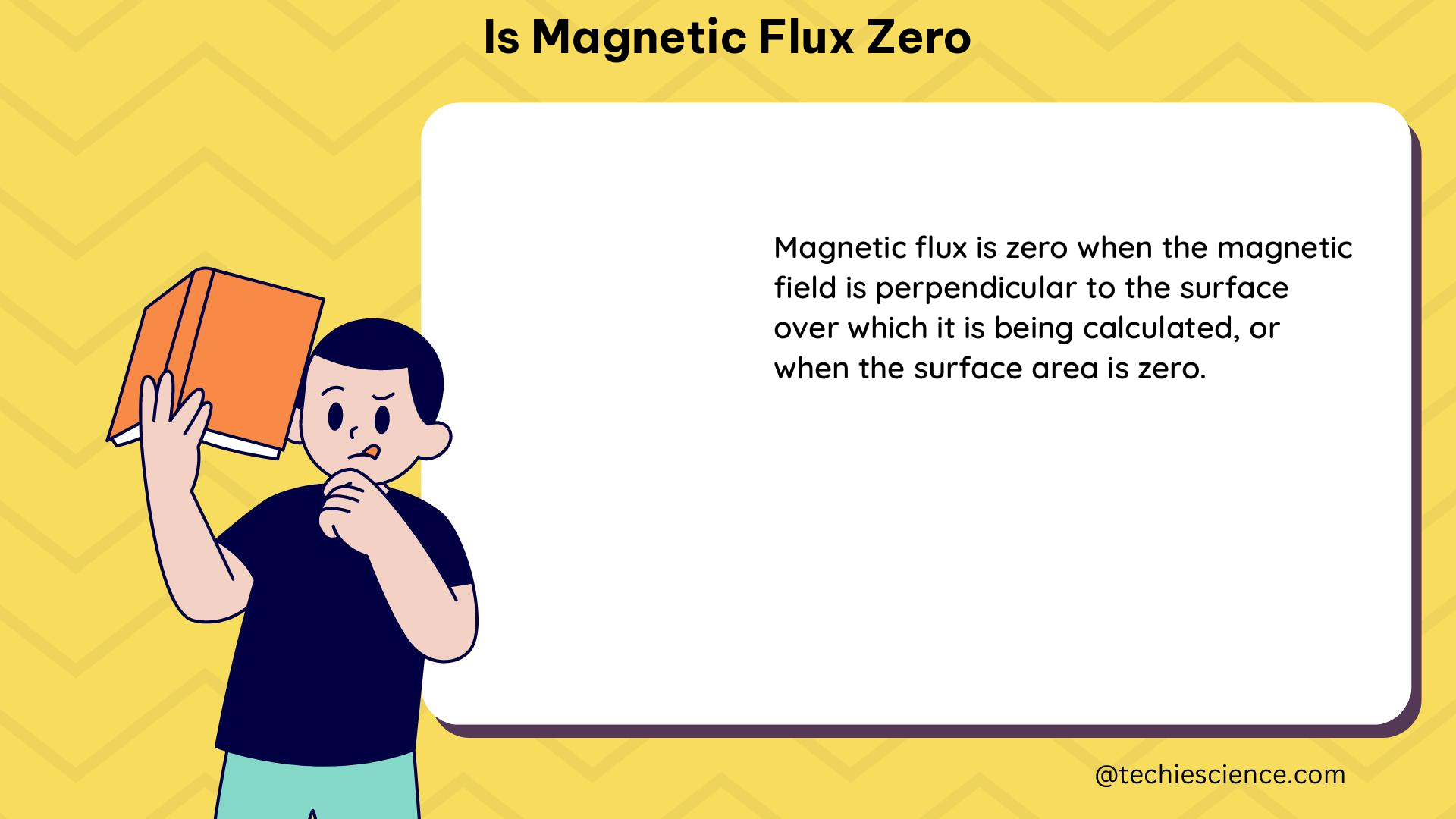Magnetic flux (Φ) is a fundamental concept in electromagnetism that quantifies the amount of magnetic field passing through a given surface. It is a crucial parameter in understanding various electromagnetic phenomena, such as electromagnetic induction, transformer operation, and the behavior of magnetic materials. In this comprehensive blog post, we will delve into the intricacies of magnetic flux, exploring the conditions under which it can be zero, and providing a detailed, technical guide for physics students.
Understanding Magnetic Flux
Magnetic flux is defined as the product of the magnetic field strength (B) and the area (A) of the surface perpendicular to the field, multiplied by the cosine of the angle (θ) between the magnetic field and the normal vector to the surface. Mathematically, this can be expressed as:
Φ = B × A × cos(θ)
Where:
– Φ is the magnetic flux, measured in Webers (Wb)
– B is the magnetic field strength, measured in Teslas (T)
– A is the area of the surface, measured in square meters (m²)
– θ is the angle between the magnetic field and the normal vector to the surface, measured in radians (rad)
The unit of magnetic flux, the Weber (Wb), is named after the German physicist Wilhelm Eduard Weber, who made significant contributions to the understanding of electromagnetism.
Conditions for Zero Magnetic Flux

Magnetic flux can be zero under the following conditions:
1. Magnetic Field Lines Do Not Cross the Surface
If the magnetic field lines do not intersect the surface, the magnetic flux through that surface will be zero. This can occur when the magnetic field is parallel to the surface or when the surface is positioned outside the region of the magnetic field.
For example, consider a rectangular surface placed in a uniform magnetic field. If the surface is oriented such that the magnetic field lines are parallel to the surface, the magnetic flux through the surface will be zero, as shown in the figure below:
In this case, the angle θ between the magnetic field and the normal vector to the surface is 90°, and the cosine of 90° is 0, resulting in a magnetic flux of zero.
2. Zero Magnetic Field Strength
If the magnetic field strength (B) is zero within the region of the surface, the magnetic flux through that surface will also be zero, regardless of the orientation of the surface.
This can happen in areas where there is no magnetic field present, such as outside the influence of a magnet or a current-carrying conductor. It can also occur in regions where the magnetic field cancels out, such as the center of a Helmholtz coil or the midpoint between two opposing magnets.
3. Perpendicular Magnetic Field
When the magnetic field is perpendicular to the surface, the magnetic flux through that surface will be at its maximum. Conversely, as the angle θ between the magnetic field and the normal vector to the surface approaches 90°, the magnetic flux will decrease until it reaches zero when the magnetic field is completely parallel to the surface.
This relationship can be expressed mathematically as:
Φ = B × A × cos(θ)
When θ = 0°, the cosine of the angle is 1, and the magnetic flux is at its maximum. When θ = 90°, the cosine of the angle is 0, and the magnetic flux is zero.
Magnetic Flux Linkage and Lenz’s Law
In the context of a changing magnetic field, such as in an AC generator or a transformer, the concept of magnetic flux linkage becomes important. Magnetic flux linkage is the total magnetic flux that links or passes through a coil or a circuit.
When the magnetic field changes, the magnetic flux linkage also changes, inducing an electromotive force (EMF) in the coil or circuit. This induced EMF is governed by Lenz’s law, which states that the direction of the induced current is such that it opposes the change in magnetic flux.
In an AC generator, the magnetic field direction changes periodically, causing the magnetic flux linkage to be negative half the time. This results in the induced EMF also changing direction, leading to the alternating current (AC) output.
Numerical Examples and Problems
To further illustrate the concept of magnetic flux and the conditions for zero magnetic flux, let’s consider some numerical examples and problems.
Example 1: Magnetic Flux in a Rectangular Surface
Suppose a rectangular surface with dimensions of 10 cm × 15 cm is placed in a uniform magnetic field of 0.5 T. The angle between the magnetic field and the normal vector to the surface is 30°.
Calculate the magnetic flux through the surface.
Given:
– Area of the surface, A = 10 cm × 15 cm = 0.15 m²
– Magnetic field strength, B = 0.5 T
– Angle between the magnetic field and the normal vector, θ = 30°
Applying the formula for magnetic flux:
Φ = B × A × cos(θ)
Φ = 0.5 T × 0.15 m² × cos(30°)
Φ = 0.0649 Wb
Problem 1: Magnetic Flux in a Circular Surface
A circular surface with a radius of 20 cm is placed in a uniform magnetic field of 0.8 T. Calculate the magnetic flux through the surface when the angle between the magnetic field and the normal vector to the surface is:
a) 0°
b) 45°
c) 90°
Given:
– Radius of the circular surface, r = 20 cm = 0.2 m
– Magnetic field strength, B = 0.8 T
a) Angle between the magnetic field and the normal vector, θ = 0°
Φ = B × A × cos(θ)
Φ = 0.8 T × (π × 0.2² m²) × cos(0°)
Φ = 0.2011 Wb
b) Angle between the magnetic field and the normal vector, θ = 45°
Φ = B × A × cos(θ)
Φ = 0.8 T × (π × 0.2² m²) × cos(45°)
Φ = 0.1421 Wb
c) Angle between the magnetic field and the normal vector, θ = 90°
Φ = B × A × cos(θ)
Φ = 0.8 T × (π × 0.2² m²) × cos(90°)
Φ = 0 Wb
These examples and problems demonstrate the relationship between magnetic flux, magnetic field strength, surface area, and the angle between the magnetic field and the normal vector to the surface. They also illustrate the conditions under which the magnetic flux can be zero.
Conclusion
In this comprehensive blog post, we have explored the concept of magnetic flux and the conditions under which it can be zero. We have discussed the formula for calculating magnetic flux, the scenarios where the magnetic flux can be zero (when the magnetic field lines do not cross the surface, when the magnetic field strength is zero, and when the magnetic field is parallel to the surface), and the relationship between magnetic flux linkage and Lenz’s law in the context of a changing magnetic field.
Through the numerical examples and problems, we have provided a hands-on guide for physics students to understand the practical applications of these principles. By mastering the concepts and techniques presented in this post, students will be better equipped to tackle problems and analyze real-world electromagnetic phenomena.
Remember, the key to understanding magnetic flux is to focus on the interplay between the magnetic field, the surface area, and the angle between them. With a solid grasp of these fundamentals, you will be well on your way to becoming an expert in the field of electromagnetism.
Reference:
- Magnetic Flux and Faraday’s Law of Electromagnetic Induction
- Magnetic Flux and Magnetic Field
- Magnetic Flux and Lenz’s Law

I am Raghavi Acharya, I have completed my post-graduation in physics with a specialization in the field of condensed matter physics. I have always considered Physics to be a captivating area of study and I enjoy exploring the various fields of this subject. In my free time, I engage myself in digital art. My articles are aimed towards delivering the concepts of physics in a very simplified manner to the readers.